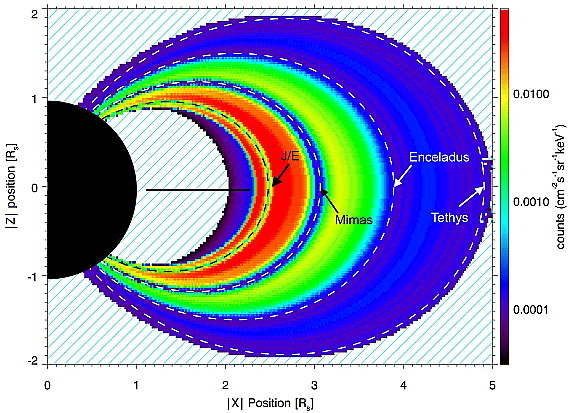Radiation belts, like Earth’s Van Allen belts, have been discovered at Jupiter, Saturn, Uranus and Neptune but it has only been possible to observe the variability of their intensity at Earth and Jupiter. Cassini has been orbiting Saturn for more than five years so it has been possible to assess changes in Saturn’s radiation belts.
An international team of astronomers made the discovery analyzing data from the MIMI’s LEMMS sensor, which measures the energy and angular distribution of charged particles in the magnetic bubble that surrounds Saturn. It is located about 377,000 km from the center of the planet.

Radiation belt map of the ions with energies between 25-60 MeV, in Saturn's magnetosphere, based on several years of Cassini MIMI/LEMMS data. The structure of this radiation belt is almost perfectly stable for more than 5 years of Cassini observations, despite the intense variability of the radiation belts, outside the location of Tethys. Credit: JPL
The Magnetospheric Imaging Instrument (MIMI) is the first instrument ever designed to produce an image of a planetary magnetosphere. It detects energetic ions and electrons and fast neutral particles, in order to study the overall configuration and dynamics of the Saturnian magnetosphere and its interactions with the solar wind. The Principal Investigator is Professor Stamatis Krimigis of the JHU/APL.
“The most dramatic changes have been observed as sudden increases in the intensity of high energy charged particles in the inner part of Saturn's magnetosphere, in the vicinity of the moons Dione and Tethys,” said Roussos. “These intensifications, which could create temporary satellite atmospheres around these moons, occurred three times in 2005 as a response to an equal number of solar storms that hit Saturn's magnetosphere and formed a new, temporary component to Saturn’s radiation belts.”
The new belt, which has been named 'the Dione belt', was only detected by MIMI/LEMMS for a few weeks after each of its three appearances. The team believe that newly formed charged particles in the Dione belt were gradually absorbed by Dione itself and another nearby moon, Tethys, which lies slightly closer to Saturn at an orbit of 295,000km.
Unlike the Van Allen belts around the Earth, Saturn’s radiation belts inside the orbit of Tethys are very stable, showing negligible response to solar storm occurrences and no variability over the five years that they have been monitored by Cassini.
It was found that the transient Dione belt was only detected outside the orbit of Tethys. It appeared to be clearly separated from the inner belts by a permanent radiation gap all along the orbit of Tethys.
"Our observations suggest that Tethys acts as a barrier against inward transport of energetic particles and is shielding the planet’s inner radiation belts from solar wind influences. That makes the inner, ionic radiation belts of Saturn the most isolated magnetospheric structure in our solar system," said Roussos.
The radiation belts within Tethys's orbit probably arise from the interaction of the planet’s main rings and atmosphere and galactic cosmic ray particles that, unlike the solar wind, have the very high energies needed to penetrate the innermost Saturnian magnetosphere. This means that the inner radiation belts will only vary if the cosmic ray intensities at the distance of Saturn change significantly.
Roussos emphasized, “Outside the orbit of Tethys, the variability of Saturn's radiation belt might be enhanced in the coming years as we start approaching the solar maximum. If solar storms occur frequently in the new solar cycle, the Dione belt might become a permanent, although highly variable, component of Saturn's magnetosphere, which could affect significantly Saturn's global magnetospheric dynamics.”






Comments